IPIHAN
Inge Aanstoot graduated in 2009 from the Willem De Kooning Academy in Rotterdam in the direction of Autonomous Art. She makes full, narrative paintings about history, science and religion, trivial facts and everyday events. This summer she stayed for 5 weeks as a guest artist in East-Germany. (Pictures: Aad Hoogendoorn)

...travel to East Germany with a group of artists to transform an empty building into a temporary mega-atelier.
A few years ago I was asked by visual artist Pim Palsgraaf if I wanted to participate in If Paradise Is Half As Nice, either IPIHAN. The project immediately appealed to me: travelling to East Germany with a group of artists to transform an empty building into a temporary mega-atelier. Unlimited work possibilities, culminating in a grand final exhibition. Pim and Daan Botlek have been organising this for a number of years and gradually more and more artists joined in.
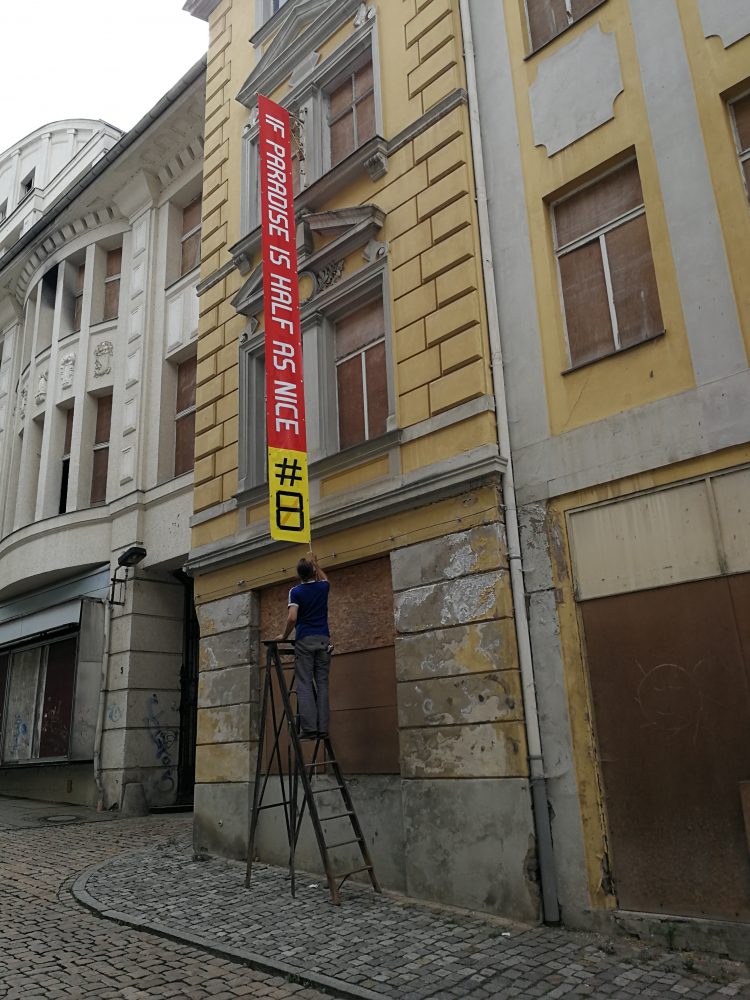
When I finally had a chance to visit the final presentation of the project last year, I soon realized what I had missed. I decided that if Pim asked me again I would grab my chance. Last May he mailed. The permanent group of about 10 German and Dutch artists asked me to join them this year as a guest artist. Of course I did! IPIHAN #8, here I come!
Whereas in the early years a building was searched and squatted on the spot, nowadays the search for a suitable location is done in advance; the owner gives permission and the key. This year, the choice fell on Altenburg, a small town of around 33,000 inhabitants, about 45 minutes' drive from Leipzig. Location: a former department store, or Kaufhausindustrial bakery and butcher shop.
The community of Altenburg was immediately enthusiastic when they heard our plans. The local culture house 'Paul-Gustavus-Haus' (PGH) had taken the IPIHAN-crew under its wings. The community of Altenburg provided us with two apartments in the north of the town.
The municipality of Altenburg was immediately enthusiastic when they heard our plans.
The image I had formed at home of Altenburg and the Kaufhaus An hour after arriving I could not exactly remember it anymore. Pim and I took the train to Nijmegen and got into the crowded car of artist Willem Besselink and historian Guus Vreeburg. Upon arrival in Altenburg, artists Regina Kelaita, Ties Ten Bosch and Michiel Jansen welcomed us with a beer on the town's market square. Altenburg immediately presented itself much more lively and friendly than Zeitz, the neighboring town where I had visited IPIHAN the previous summer. After the arrival of usual suspect Jordy Walker and guest filmmaker Sander Schuurman later that week, we were pretty much complete. Guest artist Julien Fargetton and IPIHAN'er Sybille Neumeyer were able to be there for a bit less time than the rest. Daan Botlek was a bit delayed, but he was there until the end. A fantastic group of people with whom I immediately felt at home.
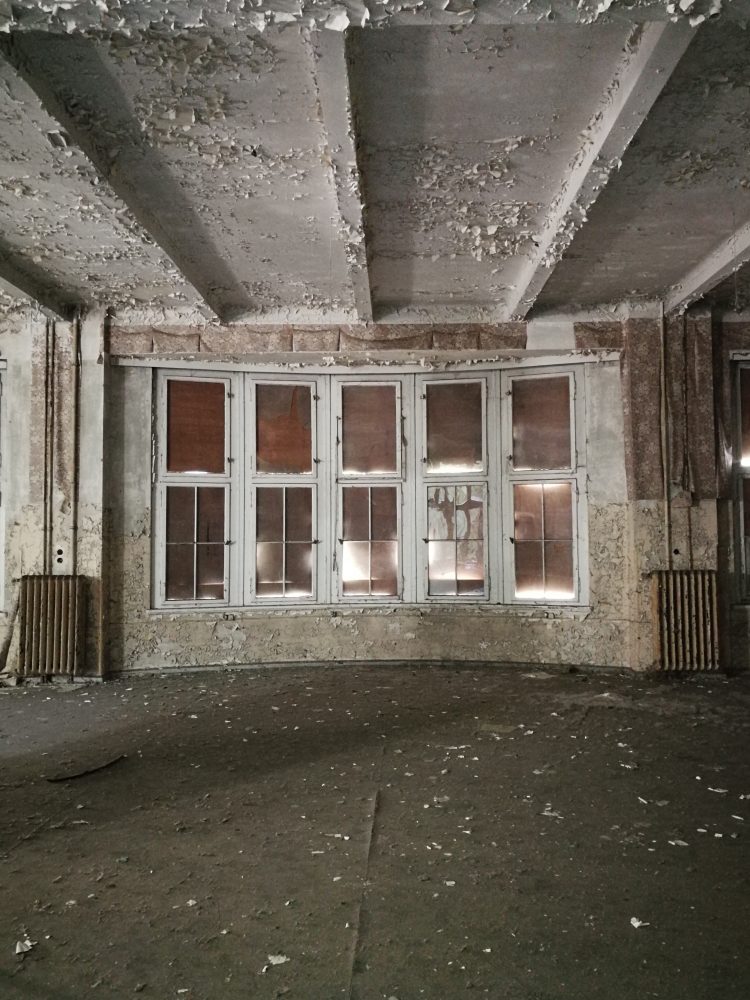 The Kaufhaus is located on Hillgasse, a small street in the middle of the city. It's not the beautiful facade that catches the eye first, but the boarded-up windows and entrance. We had the key to the gate to the courtyard. We entered through a gate under the building, the courtyard was a wild garden. It was nice and cool there; the temperatures outside the gate were significantly higher. This summer was a hot one, and Thuringia presented its continental climate.
The Kaufhaus is located on Hillgasse, a small street in the middle of the city. It's not the beautiful facade that catches the eye first, but the boarded-up windows and entrance. We had the key to the gate to the courtyard. We entered through a gate under the building, the courtyard was a wild garden. It was nice and cool there; the temperatures outside the gate were significantly higher. This summer was a hot one, and Thuringia presented its continental climate.
The building consists of a mishmash of buildings. Once inside, you see that the bakery and butcher shop are much larger than the Kaufhaus itself. Large halls and small rooms alternate. Throughout the years a lot has been rebuilt and extended. Each building can be reached in one way or the other via the inside. Only the butcher's shop at the street side (including a beautiful former butcher's shop!) was badly accessible due to an earlier fire.
In the butcher's shop, the brine and smoke rooms still smelled of sausage. Old scales and cooling rooms were overgrown with ivy.
It had clearly been tidied up before the door was shut for the last time 25 years ago. There were still some lamps, but hardly any furniture. We did find old posters, huge ovens, bags of bread flour... In the butcher's shop the salting and smoking rooms still smelled of sausage. Old scales and cold rooms were overgrown with ivy. Most of the windows were broken, around the courtyard they were not boarded up. The peeling paint on walls and ceilings gave the whole a baroque look.
The first week was reserved for preparing a basic accommodation in our Kaufhaus. We decided to turn the large empty bakery hall on the ground floor into a living kitchen. We found materials, from old oven shelves to loosened window frames, to build a countertop and sink. A fridge came from the IPIHAN storage. What we couldn't find we took from the hardware store. Outside, old doors were turned into tables and benches, a barbecue was built. We decided, because we were always tripping over things, to remove some of the ivy that covered the whole garden. A beautiful stone terrace appeared. We would later find out that 25 years ago this treed courtyard was an empty square.
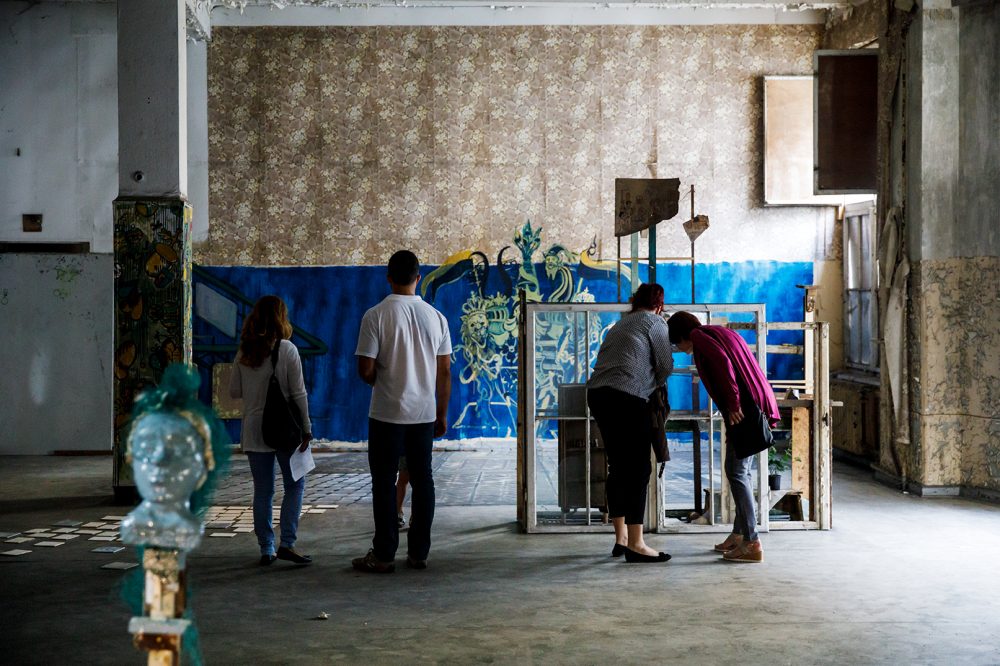 An electrician provided by the municipality installed electricity; what a heavenly silence without generators! A connection to the water supply proved unfeasible, but the PGH allowed us to fill our jerrycans every day. Little by little the building was discovered and appropriated. Ties got the old fluorescent lighting working and we hung strings of lights in the garden. We cooked in our own kitchen and barbecued on our own terrace. After just a few days our sense of time started to change, and until the end there was a remarkable cognitive dissonance: on the one hand it seemed like only yesterday that we arrived, on the other hand it felt like we had been living here for months.
An electrician provided by the municipality installed electricity; what a heavenly silence without generators! A connection to the water supply proved unfeasible, but the PGH allowed us to fill our jerrycans every day. Little by little the building was discovered and appropriated. Ties got the old fluorescent lighting working and we hung strings of lights in the garden. We cooked in our own kitchen and barbecued on our own terrace. After just a few days our sense of time started to change, and until the end there was a remarkable cognitive dissonance: on the one hand it seemed like only yesterday that we arrived, on the other hand it felt like we had been living here for months.
The history of Altenburg goes back more than 1000 years, and Emperor Barbarossa made it a residential town in the 12th century. The residence castle is located on a rock in the centre of the city. The city is full of churches, and there are towers everywhere. Every evening at 10 pm the carillonneurs treated us to lullabies. When we sat on the roof in the evening, you could hear it all around you in incredible surround sound.
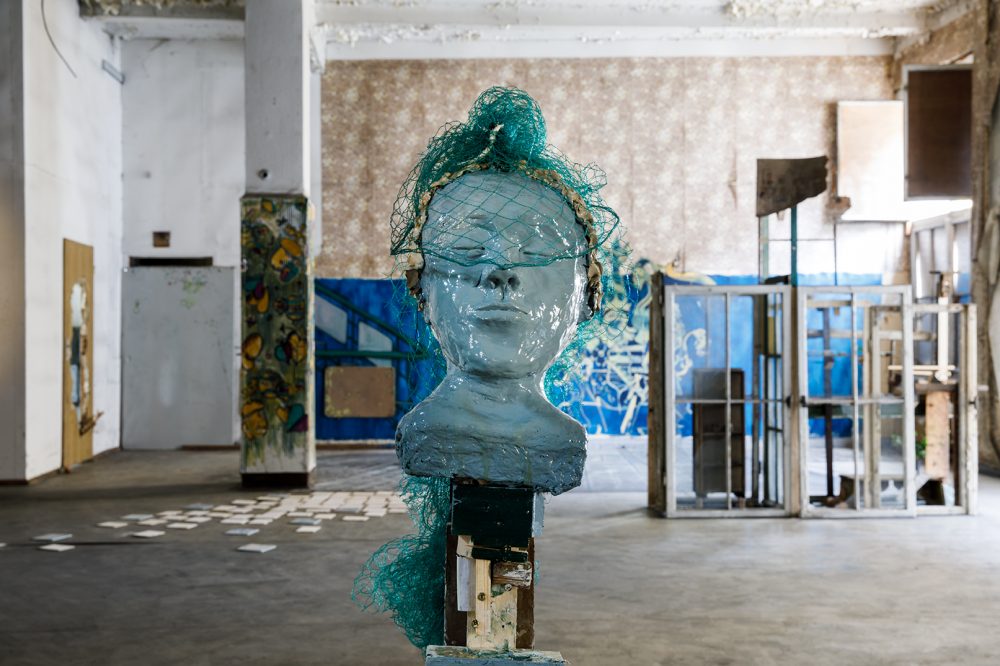 When we all started working for ourselves after the first week, I immersed myself in the history of the city. I visited museums, the castle, churches and towers, the local postcard shop, the Skatbrunnen. Altenburg is, in addition to being the birthplace of the Skate gameIt is also the birthplace of several important scientists. I gathered more and more information about a city which, since the fall of the wall, has only lost importance, population and lustre, but whose inhabitants keep their spirits up and lovingly renovate façades, resurrect old (and new) festivals and also welcome our project with open arms.
When we all started working for ourselves after the first week, I immersed myself in the history of the city. I visited museums, the castle, churches and towers, the local postcard shop, the Skatbrunnen. Altenburg is, in addition to being the birthplace of the Skate gameIt is also the birthplace of several important scientists. I gathered more and more information about a city which, since the fall of the wall, has only lost importance, population and lustre, but whose inhabitants keep their spirits up and lovingly renovate façades, resurrect old (and new) festivals and also welcome our project with open arms.
Historian Guus collected stories about the building - calls to newspapers and meetings with representatives of the city council and city archive ensured that people were rattling the gates every day with photos and anecdotes. He presented his findings, and in doing so further stimulated my interest in Altenburg's history.
Gradually a portrait of the city emerged. The stories of famous and less famous Altenburg citizens formed the inspiration for the large installation I would eventually build.
The purpose of IPIHAN is to work undisturbed and experiment. For a long time I wanted to do something else than painting, and I did. I decided to settle down on the middle floor of the KaufhausHe was intrigued by the similarities between a shop window and a museum display case.
Gradually a portrait of the city emerged. The stories of famous and less famous Altenburg citizens formed the inspiration for the large installation I would eventually build. I made murals about noble families and portraits of Altenburg scientists. A sculpture based on a half renovated statue on the facade of the station became an allegory of the city, a semi-fictional diorama of the city centre was completed by a display case full of materials from the building.
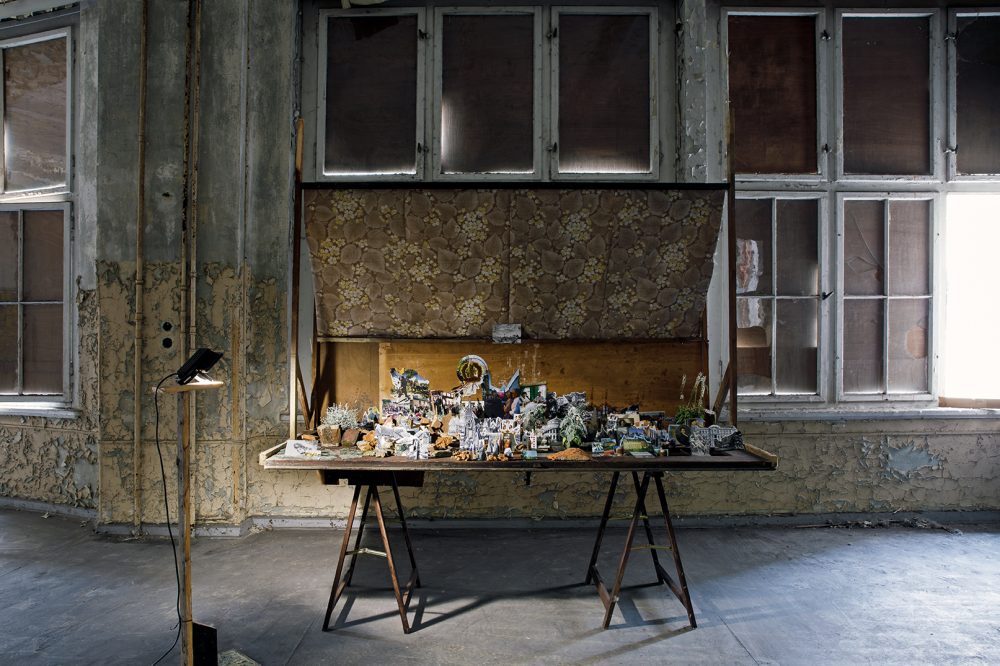 Each artist went his own way. One made a room-filling installation, the other an intimate sculpture or film. Where one did precise research, the other was raging. In the evenings, we took turns cooking, often after a dip in the outdoor pool around the corner. One by one we moved into dorms and tents in the building, though the apartments remained available for shower, washing machine and bed. We drank beers donated by an anonymous patron we suspected was the enthusiastic young mayor. We worked hard, had a lot of fun, treated ourselves to the occasional evening schnitzel restaurant.
Each artist went his own way. One made a room-filling installation, the other an intimate sculpture or film. Where one did precise research, the other was raging. In the evenings, we took turns cooking, often after a dip in the outdoor pool around the corner. One by one we moved into dorms and tents in the building, though the apartments remained available for shower, washing machine and bed. We drank beers donated by an anonymous patron we suspected was the enthusiastic young mayor. We worked hard, had a lot of fun, treated ourselves to the occasional evening schnitzel restaurant.
In the fourth week we completed our projects. Week five was dedicated to making the building visitor-proof; from locking dangerous areas and lighting works of art to carpentry of bar and djbooth. Toine Klaassen joined us, he took care of the opening performance. We started to wonder how busy it would be during the opening weekend, given the attention from the local media over the weeks. The Kaufhaus turned out to be a lost gem of the city; everyone knew it and missed it. Guus almost drowned in the supplied material. There were photos from 1927 onwards.
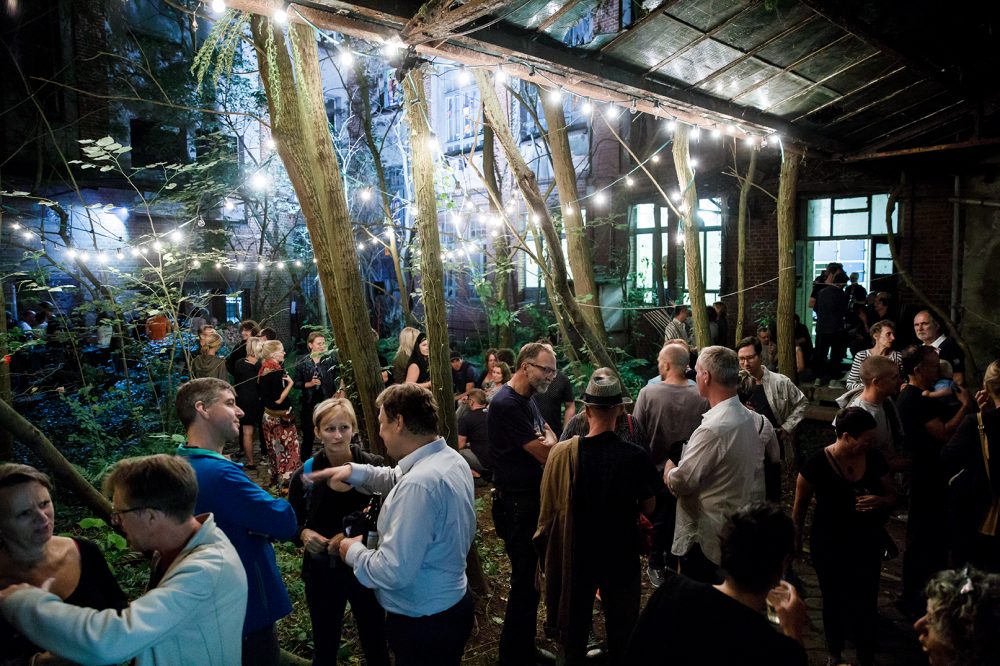 With all this enthusiasm, we thought we'd hit the 1000 visitor record this year, even though we weren't in the heart of Leipzig. If only because the locals wanted to see the inside of the building again. Our expectations were exceeded: we received 3000 visitors! Halfway through the first evening all the food was gone, all the tours were overcrowded. We ran, flew, partied and improvised all over the place. The people of the PGH helped us with God knows what at every turn. It was an enormous success. Sunday night, after the gate closed, we danced to Sanders' gabberhouse and slept through the day. Then the winding down began, and three days later I was suddenly on the train home.
With all this enthusiasm, we thought we'd hit the 1000 visitor record this year, even though we weren't in the heart of Leipzig. If only because the locals wanted to see the inside of the building again. Our expectations were exceeded: we received 3000 visitors! Halfway through the first evening all the food was gone, all the tours were overcrowded. We ran, flew, partied and improvised all over the place. The people of the PGH helped us with God knows what at every turn. It was an enormous success. Sunday night, after the gate closed, we danced to Sanders' gabberhouse and slept through the day. Then the winding down began, and three days later I was suddenly on the train home.
I could tell hundreds more stories.
I could tell hundreds more stories. Five weeks; it's long and short at the same time. IPIHAN is a wonderful project that I participated in with love; the most fantastic, crazy roller coaster you can fill your summer with. It runs on crowdfunding and unbridled commitment from the group - and partly on the Spenden of 3,000 generous Altenburgers! I can recommend everyone to come along this summer to IPIHAN#9 to visit. I will be there in any case. Until then!


